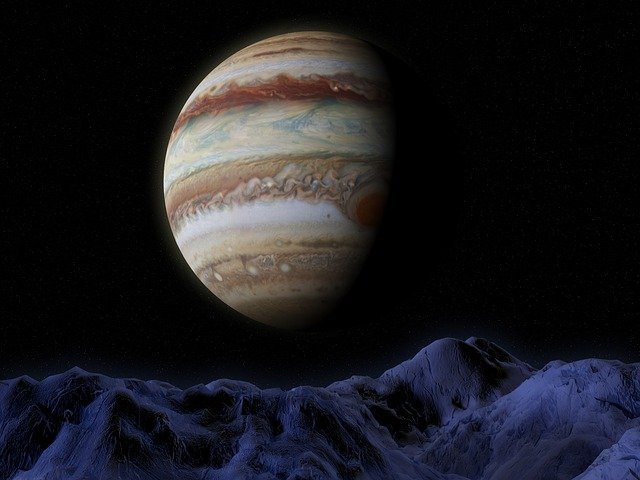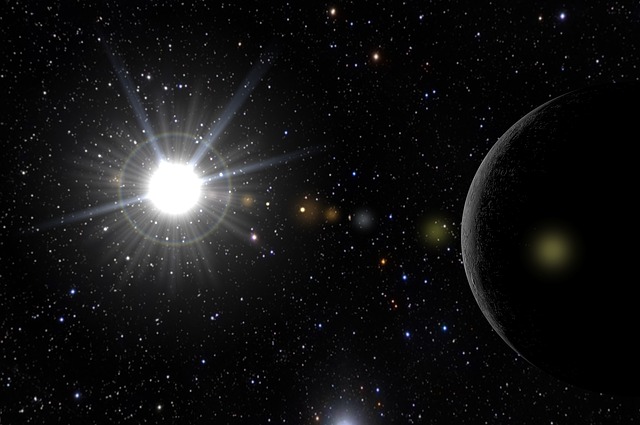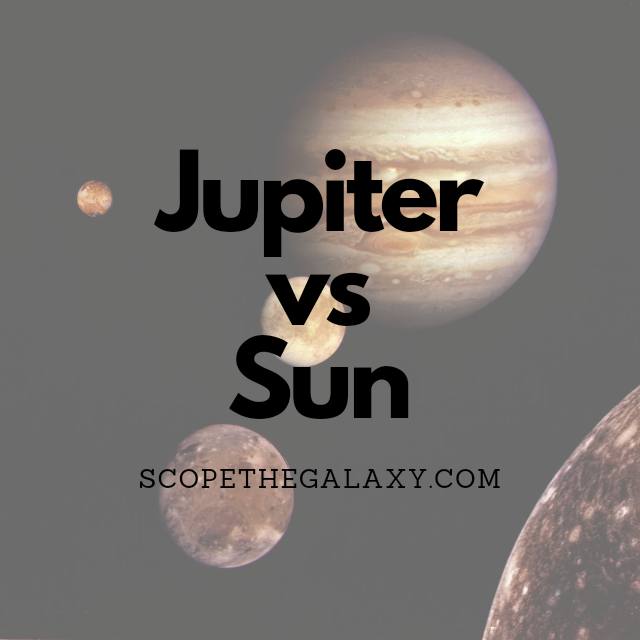*This post may contain affiliate links. This means we may make a commission if you purchase an item using one of our links*
The main differences between the Sun and Jupiter is that the former goes through nuclear fusion, which allows it to create light, is roughly 10 times the width of Jupiter, is hotter and far heavier than Jupiter, weighing roughly 1000 times more than the gas giant.
Both celestial objects are similar in how they are composed and even in regards to their age but, they function very differently from one another. For a more detailed look at differences, continue reading as I’ll be covering it more thoroughly below.
What Is The Planet Jupiter?
Table of Contents

Jupiter is the 5th farthest planet from the Sun and the largest planet within our local solar system. The planets most recognisable traits is the giant red spot visible on its atmosphere along with the brown horizontal bands flowing across its being.
Jupiter falls under the classification of a gas giant. This is because its composition mostly consists of the elements hydrogen and helium. The split is roughly 71% hydrogen, 27% helium, with the remainder of the elements split throughout the left over 2%.
As the biggest planet in our solar system, Jupiter is roughly 143,000 km or 1,300 Earths in diameter, it has a mass of around 0.001 solar masses, the temperature when inside the clouds are roughly -145 degrees celsius whilst the core is far hotter, equating in the region of 24,000 degrees celsius.
Due to its extreme circumstances, gaseous composition and distance from the Sun, the planet is not theoretically capable to support life, from its subzero temperature to the extremely fast 400mph winds, and its gravity which may be unsustainable for our bones, roughly 2.4 times greater than Earth’s.
Although the conditions on Jupiter aren’t suitable for us, some of its 79 moons like Europa for example could support life.
Jupiter has a relatively fast rotation around its axis where 1 rotation typically takes 10 hours to make whilst its orbit around the Sun is far longer taking in the region of 12 years for 1 full cycle.
Another feature of Jupiter that is renowned by astronomers is the strength of its magnetic field. In comparison to the other planets in our solar system it is even stronger than our Sun, where it’s over magnetosphere is roughly 20,000 times the strength of Earth.
What this means is that Jupiter’s magnetosphere is able to avert solar winds that are 3 million kilometers away from it.
What Is The Sun?

The Sun is the bright, celestial entity at the center of our solar system and is also a star that falls under the G type main sequence star bracket (also called a yellow dwarfs), all of which are medium sized stars that tend to be around 0.84 – 1.15 solar masses.
Our Sun is 1 solar mass, making it a medium sized medium star. It’s also on the brighter side for a yellow dwarf, the color that it emits is white as opposed to the slightly yellow that less luminous yellow dwarfs would be.
Of course we still see the Sun as yellow or even red on Earth but, the reason for this significant color shift is because our atmosphere scatters and breaks up the photons that reach us, ultimately changing the true color of the light rays from white to the yellow, orange or red we see in our day to day.
As it is a star, the Sun will actively convert the hydrogen elements at its core into helium, through a process called nuclear fusion.
Nuclear fusion is the reason why it generates light and produces the energy we receive, helping us power machinery, technology, grow crops so on and so forth.
The process of nuclear fusion also affects how hot our star burns, allowing the sun to hit temperatures around 6000°C on a daily basis. This will be the case for another 4.5 – 5 billion years until it’s unable to convert hydrogen into helium.
Once hydrogen cannot be converted, an imbalance between the inward and outward forces keeping the Sun together will occur, causing an imbalance which would result in our Sun bloating up many many times its current size.
When this happens it will enter its red giant phase, where it’ll be around 256 times larger than it is now.
This phase will last for around a billion years until it sheds it mass through a process called planetary nebula, leaving behind only a dead white dwarf remnant.
Is Jupiter A Failed Sun?
No, Jupiter is not a failed star or a brown dwarf as some would refer to it as. The reaosn for this minor confusion is down to the fact Jupiter’s diameter is similar to that of a brown dwarf.
However, other than the composition of the gas giant being somewhat similar to a stars, thermonuclear fusion does not occur at its core due to its lack of mass therefore, it cannot be classified as a star.
If say Jupiter was at least 13 times its size, it may have become a failed brown dwarf star or roughly 80 times larger to become a main star sequence but, this isn’t the case and likely will not ever be the case.
Mass is what is most important for any celestial object to become a star but, Jupiter has never has and likely never will achieve the required mass to become one.
Similarities Between Jupiter And The Sun
The main similarity between Jupiter and the Sun would have to be down the similar gaseous composition. This is because both entities are made mostly made of hydrogen and helium. Both are also roughly the same age too, eclipsing the 4.6 billion year mark in total.
Other than this, the two don’t have too many commonalties between them.
Differences Between Jupiter And The Sun
As for what the difference between the two are, they include the following:
- The Sun is able to create its own source of light through nuclear fusion whilst Jupiter cannot.
- The Sun is far hotter than Jupiter where its average temperature is around 6,000 degrees celsius and the core is 15 million degrees whereas Jupiter is -145 degrees celsius within its atmosphere and 24,000 degrees at its core.
- The Sun’s gravitational strength is far stronger than Jupiter’s due to its relative size difference.
- Jupiter has a stronger magnetic field than even the Sun where the Sun is roughly 1 Gauss and Jupiter is 4.3 Guass.
- The Sun has a projected lifespan of 10 billion years in total whilst Jupiter doesn’t have any clear conditions pointing towards it dying unless a stars gravitational force pulls the planet apart or through any other catastrophic cosmic incidents.
- The Sun is bright white in color whilst Jupiter is a mixture of light and dark brown in color.
- It takes Jupiter 10 hours to rotate around its axis whilst the Sun completes 1 rotation once every 27 days.
Summary
Besides the similarities in age and composition, Jupiter and the Sun are very different from one another, whether it be the amount of energy each celestial body produces, the temperatures at which they consistently remain, even to the differences in magnetic fields and rotation cycles.
In simple terms, although grand size, Jupiter is simply another gas giant that orbits the yellow dwarf we call the Sun.

